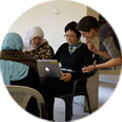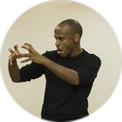From Sequence to Hierarchy:
Why Achieving Combinatoriality is Harder than We Think
W. Tecumseh Fitch
University of Vienna
The ability of nonhuman animals to structure both their actions and perception sequentially is well documented, and sequencing appears to rely on similar mechanisms in human phonology. However, syntax requires, in addition, hierarchical structure which appears to rely on different neural mechanisms that are more highly developed in humans than other species. But, although phonology is hypothesized to require computations limited to the finite state (regular) level, phonology too has an apparent hierarchical structure, with phonological phrases containing words that contain syllables that contain segments made of distinctive features. Furthermore, recent data from both birdsong and human babbling suggest that deriving free combinatoriality from the sequences that make up such vocalizations is far from trivial: an unexpected limitation in the flexibility of learned, complex signals. I will suggest that the fixed-depth hierarchical structure observed in phonology represents a middle term in the evolution of language, which is both powerful (granting free combinatoriality) and a crucial step towards the arbitrary depth hierarchicality seen in phrasal syntax, ending with some speculations about the brain basis for this ability and how it could evolve from sequential precursors.
Compositionality in Chimpanzee Communication?
Linda Oñai, Katja Liebalii, and Wendy Sandleriii
iMax Planck Institute for Human Development, Berlin, Germany, iiFree University of Berlin, iiiUniversity of Haifa
Language evolution research seeks commonalities and differences between non-human primate communication and human language. One important feature of human language, compositionality, lends language a high degree of flexibility and is thought to be a uniquely human characteristic. We studied multimodal expressions in our closest living relative, the chimpanzee, and investigated whether hand gestures and facial expressions recombined to create different complex meanings. In our analysis, ‘meaning’ was attributed to signals on the basis of both context of use and response of recipients. We focused on two variations of the extended arm gesture -- Arm Stretched (AS) and Arm Offer (AO) -- in isolation, and in combination with two facial expressions, Bared Teeth (BT) and Funneled Lips (FL). In positive contexts, both hand gestures elicited an affiliative response when used in isolation, while their combination with the BT facial expression modulated the recipient’s response in different ways. BT+AS elicited a significantly higher frequency of affiliative responses than AS alone, while BT+AO resulted in lower frequency of affiliative responses than AO alone. Our study identifies distinct components that recombine to trigger different response tendencies – and thus represents a first step in exploring compositionality in chimpanzee multimodal expressions.
Improvisation, Interaction and Iteration in the Evolution of Linguistic Structure: Evidence from Artificial Sign Language Experiments
Simon Kirby
Centre for Language Evolution
University of Edinburgh
There are three distinct mechanisms that drive the cultural evolution of language: improvisation (the spontaneous invention of new communicative solutions without prior convention), interaction (the repeated use of signals for the purposes of communication between individuals), and iteration (the transmission of sets of communicative conventions to a new generation of learners in a population). Using a series of laboratory experiments where hearing participants communicate using only their bodies and no speech, our lab has investigated the different biases that these three processes bring to bear on an evolving language. Specifically, we show that improvisation leads to iconic/natural signals; interaction leads to convergence on communicatively efficient signals; and iteration leads to systematicity. I will argue that the design features of human language are the natural result of cultural evolution in the presence of these three mechanisms, each of which comes to the fore at a different stage in the emergence of language.
Decoupling of Pointing and Gaze in Israeli Sign Language and Gesture:
Emergence of an Abstract/Concrete Reference Distinction
Kate Meshi, Svetlana Dachkovskyii, Rose Stampiii and Wendy Sandleri
iUniversity of Haifa, iiGordon Academic College of Education, iiiBar Ilan University
One account of sign language emergence posits that pointing is first used with ‘concrete’ functions (e.g., indicating present referents), and only later develops ‘abstract' functions (e.g., anaphora). We present the first study to put this account to the test using data from a young sign language, Israeli Sign Language (ISL).
Study 1: We analyzed pointing in three generations of signers, whose signing can be understood to reflect the structure of ISL at different stages in its emergence. If ISL began with concrete pointing functions and later developed abstract ones, we should see the following in younger signers: (1) more points with abstract functions, and (2) evidence in the form of the pointing sign, showing that concrete and abstract pointing functions have diverged. Our findings provide just this evidence: relative to older signers, young signers produced more abstract points, and used the presence or absence of aligned eye gaze to more consistently distinguish concrete from abstract points.
Study 2: We compared the original signer group with a set of age-matched, non-signing Hebrew speakers. Speakers showed the same pointing behaviors across age groups: notably, speakers all tended to use point together with eye gaze for concrete reference, and for abstract reference they decoupled the two, using point only. Considering that speakers all have a fully conventionalized language that distinguishes concrete from abstract reference linguistically, we suggest that their gesture behavior is derived from this linguistic distinction. In a young sign language, the distinction must be forged over time, which is indeed what Study 1 attests. That the end of this process made the points of young signers more like those of speakers reveals that abstract pointing functions are common to users of full linguistic systems, whether spoken/gestural or signed.
Compositionality in the Expression of Emotions
Federica Cavicchioi, Svetlana Dachkovskyii, iii, Livnat Leemorii,
Simone Shamay-Tsooryii, Wendy Sandlerii
iUniversity of Padua, iiUniversity of Haifa, iiiGordon Academic College of Education
Emotions are complex internal states that we communicate with intricate displays of face and body actions. Are these displays phylogenetically hardwired and holistic motor programs, or does each face and body feature contribute an identifiable meaning to the overall display? To address this question, we borrow a concept from linguistics – compositionality – according to which complex linguistic expressions are built up from simpler parts, each contributing an element of meaning to the whole.
We coded pictures of athletes photographed within moments of winning and losing a competition. Participants rated the pictures on a continuum between opposing emotional states, e.g., submissive/dominant, ashamed/proud, sad/happy. Multiple mixed effect regressions determined which facial and body signals predicted each emotion.
We found that single features of the face distinguish among positive emotional states like happy and proud, while body features such as shoulder asymmetry vs. collapsed upper body distinguish negative emotions with unexpected outcome (frustrated, angry) from other negative emotions related to resignation (sad, ashamed). We conclude that body and face components modulate emotion recognition, potentially providing an ancient scaffolding upon which, millions of years later, the abstract and constrained compositional system of human language could build.
The Grammar of Empathy:
Emotional Body Displays that Trigger Vicarious Victory
Livnat Leemori, Federica Cavicchioii, Simone Shamay-Tsooryi, and Wendy Sandleri
iUniversity of Haifa, iiUniversity of Padua
Empathy is the ability to feel, share and understand the emotions and thoughts of others. Evolutionary accounts hold that empathy evolved to motivate prosocial behaviors aimed at alleviating the distress of group members, and thus most studies on empathy have focused on negative situations. Furthermore, no studies to date have investigated the specific relation between the bodily displays of others’ emotions and positive and negative empathy. Here we conduct two studies to enhance our understanding of empathy.
Using as stimuli pictures of athletes who have just won or lost a competition, we show in Experiment 1 that the degree of positive empathy is comparable to the degree of negative empathy experienced, in contrast to the prevailing belief. Supported by research showing that body expansion/contraction is associated with victory/defeat and with dominance/submissiveness, respectively, in experiment 2 we show that features determining the degree of body expansion of the protagonist affect vicarious empathic experience. Taken together, the findings suggest to us that signaling dominance through body expansion is a strong trigger for vicarious victory, potentially offering a change in hierarchical social position for individuals in the group.
Ebisu Sign Language Theatre Laboratory:
Performance as Research, from Phase 1 to Phase 2
Gal Belsitzman and Atay Citron
University of Haifa
The Ebisu Sign Language Theatre Laboratory was created as part of the Grammar of the Body Project, in order to explore the nature and limits of bodily expression by deaf signing actors in a theatrical medium. The work proceeded in two phases.
Phase 1 began in June 2014 and led to the conception of the first production, ‘It’s Not About Ebisu’. During this phase, the actors were engaged in forging the group’s identity and establishing their working methods (“the Ebisu tool-kit”), by combining devices from sign language and physical theatre.
During Phase 2, the actors further explored their physical expressivity and the performative potential of sign language. Signs, idioms and metaphors were studied through theatrical techniques, leading the actors to creatively stretch the bounds of linguistic devices of sign language, such as iconicity and simultaneity. Phase 2 focused more on deaf culture and ideology, using the actors’ personal experiences as theatrical material. This phase led to Ebisu’s second production, ‘Their Language’, which dealt with oral education and the oppression of deaf and hard of hearing children within the education system.
This talk will focus on Phase 2, through the analysis of videos from studio work and the second show.
Mind, Body, and Linguistic Form
Wendy Sandler
University of Haifa
The first half century of linguistic research on sign languages sought in these languages the same essential properties that characterize spoken languages. This enterprise was successful, and the similarities, including formal similarities, between languages in the two modalities, are indeed striking and often surprising. These results seemed to support the Chomskyan view that it is a computational system in the brain that determines linguistic structure, independent of the ‘sensorimotor system’ – i.e, independent of the body, which is considered secondary.
My goal here is to bring evidence from sign language in favor of a paradigm that works in the opposite direction, from thought units to the body, and from there to linguistic form. I show that this core thought unit, typically corresponding to a prosodic phrase, accrues linguistic form by the exigencies of the human body through communication over time. The evidence comes from (1) “modality effects” such as iconicity/arbitrariness and simultaneity/linearity, (2) the emergence of sign language from scratch, and (3) comparison of prosodic phrases and their content across modalities and across generations in language emergence. ‘Modality effects’, determined by the body, are not peripheral, but rather are critical to the structuring of language in both modalities.
Constructing Discourse Complexity with the Body
Svetlana Dachkovskyi,ii, Rose Stampii,iii, and Wendy Sandlerii
iUniversity of Haifa, iiGordon Academic College of Education, iiiBar Ilan University
Human language is understood to be a complex system. Does language start life with such complexity, or does it develop gradually over time? A preliminary study of the emerging Al-Sayyid Bedouin Sign Language suggests the latter, showing that additional bodily articulators were recruited by successive generations of signers to convey new linguistic functions. To test these results and explore this phenomenon systematically, we study three age groups in a different sign language of the same age, Israeli Sign Language (ISL), and approach the analysis with hierarchical models of discourse structure that are well established for spoken languages.
We confirm that, as with ABSL and other, more established sign languages, discourse relations are marked primarily by bodily movements by all age groups. However, by intricate coding of body movements in 15 narratives, we find that only younger signers distinguish different levels of the discourse hierarchy with their bodies: Higher levels are marked by larger movements and more articulators, while lower levels are marked by smaller movements and fewer articulators. Older signers do not reliably distinguish between these levels, tending to use the same body actions regardless of the level of the discourse relation. Younger signers also use fewer and more reduced articulations for all discourse relations, than older signers. The study reveals how linguistic expressions gradually become more complex as a language matures.
Recruiting Body in Reference Tracking in Sign Language
Rose Stampi,ii, Svetlana Dachkovskyi,iii, and Wendy Sandleri
iUniversity of Haifa, iiBar Ilan University iiiGordon Academic College of Education
Speakers and signers use an array of sophisticated strategies to track reference to discourse entities. The degree of explicitness of the reference depends on whether the referent is new (e.g., first mention) or given (e.g., reintroduction or maintenance of a previously mentioned referent). One means of signaling information status is the choice of referring expressions. For example, we may introduce a character with a noun phrase ‘the girl’ and later refer back to the same character by using a pronoun ‘she’. The second means of signaling information status is phonetic reduction (e.g., shortening and merging previously introduced referents).
Our project addresses both aspects of reference tracking over two studies: one investigating how different strategies of reference tracking emerge in a young sign, and the second investigating phonetic reduction of reference in a narrative. The findings of the first study indicate that early on, signers favour both lexical symbols and mimetic use of the body for reference. Over time, more abstract structures with more simultaneous complexity increase. In the second study, which uses sophisticated motion tracking technology, we find that a number of kinematic characteristics (i.e., sign duration, volume) differ depending on the referent status. The overall results indicate that predictable information is less explicitly marked even in a young sign language, suggesting that this is a universal communication-based phenomenon.
The Clinality of Noncompositionality in Language Genesis
John McWhorter
Columbia University
No human language, immersed in the contingencies of culture and history as well as mere semantic drift, could maintain strict compositionality in all tokens of compounding and derivation. The referent of goal kick is more specific than the independent meanings of goal and kick; the meaning of overlook (as in to neglect) is a metaphorical extension of the meanings of over and look. However, noncompositionality expresses itself in languages in degrees, in a fashion indicative of a grammar’s age. Pidgin and creole languages suggest that at emergence, a language’s noncompositionality is at a markedly less opaque stage than in languages that have been in existence and use for millennia. In Mandarin, for example, noncompositionality in compounds occurs in degrees, ranging from the relatively transparent diàn-yĭng film-shadow “movie” to dōng-xi east-west “thing.” In a new language such as Saramaccan creole, born in the late seventeenth century from a pidgin-level English, noncompositionality is largely, and perhaps totally, restricted to the former point on the Mandarin cline – truly opaque compounds have yet to emerge. Baákama black-person refers to someone who has lost a spouse and is thus feeling “black,” boókó hédi break-head means “worry,” but these are clearly less opaque than “east-west” referring to “thing.” While it may seem that noncompositionality, driven by the cognitive fundamenatal of metaphorical extension, is a design component of human language, its manifestation in degree suggests that it is ultimately an accidental feature, useful in charting languages’ age analogously to the use of alterations in mitochondrial DNA in genetic analysis.
Effects of Language Modality, Age, and Usage on Phonological Complexity in Three Sign Languages
Hope Morgan, Rama Novogrodsky, and Wendy Sandler
University of Haifa
Given the high degree of simultaneous phonological encoding in sign language, there has long been an interest in understanding what, if anything, constrains the combinatoric possibilities of components in a signed word. Constraints that restrict highly complex articulations are observed for the two hands (Battison 1978), features of hand configuration (Sandler 1996), and the number of simultaneous movements (Brentari 1998). Yet while these studies assume similar constraints on phonological complexity across sign languages, no previous analysis has tried to quantify complexity for multiple parameters across an entire sign language lexicon.
In this talk, we use a per-sign complexity index to compare three sign languages (SLs) with different histories: American SL, Israeli SL, and Kenyan SL. We find that all three languages show a similar distribution overall, which is highly skewed toward less complexity; yet statistical differences emerge that suggest an increase in complexity for older languages. We also find that how frequently a sign is used is correlated with its complexity: more common signs are significantly less phonologically complex. Two possible factors are discussed: (i) a downward pressure that restricts complexity over time, and (ii) an upward pressure for increasing discriminability and gradual accretion of complexity.
Morphological Evolution in Real Time: Mindless or Mindfree?
Mark Aronoff
Stony Brook University
A growing stream of research over the last decade has shown the value of the Darwinian principle of competitive exclusion (Gause’s Law) for understanding the organization of systems far beyond biology, from the evolution of planets to human culture, including detailed aspects of the structure of languages. Thus, we can best understand the distribution of rival morphological realizations in terms of linguistically-defined ecological niches. For example, a number of suffixes in written English form abstract nouns from adjectives: -ness, -ity, -th, -ce. They are distributed in terms of morphological environments or niches, with each productive in a particular niche. Competitive exclusion also predicts that two or more realizations that begin as synonyms may become semantically distinctive, allowing both to flourish, as attested by word pairs like historic/historical or economic/economical. I will report on the English adjectival privative ‘suffix’ -free, which has become productive since the beginning of the 21st century. The niche for the newly emerging -free pattern is semantic, signaling an unusual speaker-oriented lexical implicature, roughly ‘it is good to be xfree’. Using novel computational and web-based methods, which are interesting in and of themselves, we will show that the proportion of Xfree words corresponding to Xless words has increased rapidly from 1/80 (listed in OED) to 2/3 (attested online). Competitive exclusion is design-free, in biology and everywhere else. it makes no prediction about the properties of a new entity, only that these properties must make that entity distinct. The novel meaning type of the -free pattern is easily accommodated within such a framework but makes little sense within a more traditional linguistic theory.







